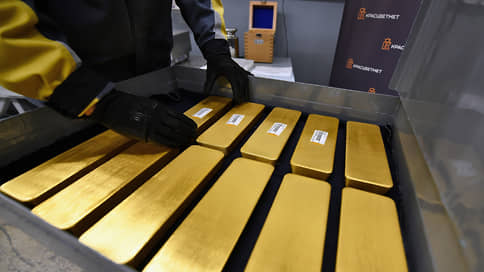Gold goes into reserves – Newspaper Kommersant No. 204 (7405) dated 02.11.
[ad_1]

In the third quarter, central banks in predominantly developing countries purchased a record amount of gold for their reserves. For the quarter, they bought almost 400 tons of metal. Interest in gold from private investors and jewelers is also growing, but quotes are holding back record sales by exchange-traded funds. Until the end of the year, prices will remain in the current range of $1.6-1.7 thousand per ounce, analysts say.
According to World Gold Countyl (WGC), world gold production in the third quarter increased by only 1%, to 1215.2 tons. At the same time, metal consumption increased by 28%, to 1,181.5 tons. The main reason for the growth in demand was a sharp increase in metal purchases by central banks. In the third quarter, they bought a record 399.3 tons (four times more than a year earlier), according to WGC estimates, and their share in demand reached a third.
Since the beginning of the year, central banks have purchased 673 tons, the highest volume since 1967.
The largest buyers who disclosed the figures were the central banks of Turkey (30 tons), Uzbekistan (26 tons), Qatar (15 tons). Buyers of more than 300 tons are not disclosed.
As the WGC explains, not all regulators report gold reserves, and some of them do so with a delay. Thus, the People’s Bank of China bought more than 600 tons of gold in 2009-2015, and announced this only in mid-2015, showing an increase in metal reserves by 1.5 times, to 1,658 tons. In the next three years, he regularly reported on operations, but since the end of 2019 he stopped again.
The Central Bank of the Russian Federation was a key market participant from 2014 to the beginning of 2020, having bought 1.24 thousand tons of gold during this time and bringing its volume in gold and foreign exchange reserves (GFR) to almost 2.3 thousand tons. However, as gold miners note, the Russian regulator is not currently buying the metal.
“In the domestic market, a situation has developed when the Central Bank does not purchase gold, and commercial Russian banks use unreasonable lowering discounts,” says Sergey Kashuba, head of the Union of Gold Producers of the Russian Federation. In mid-October, Deputy Chairman of the Central Bank Alexei Zabotkin at a meeting in the Federation Council declaredthat the regulator bought gold in March-April to stabilize the situation, but subsequently stopped, including because it creates “an additional impetus to the growth of the money supply.”
High interest in the metal from central banks support record inflation and the risks of a recession in the global economy, analysts say. Gold looks affordable against the backdrop of a much more expensive dollar “and can play a stabilizing role,” said Valery Yemelyanov, an expert on the stock market at BCS World of Investments. At the same time, geopolitical risks have grown. “The precedent with the freezing of the Russian foreign exchange reserves increased the risks of holding reserves in leading currencies. Therefore, the issue of diversifying assets is now the most relevant for regulators,” says Dmitry Skryabin, portfolio manager at Alfa Capital.
Rising inflation in the world spurs interest in the precious metal on the part of private investors. Nearly 245 tons of gold were purchased in the form of bars and coins in the third quarter, up 36% from the third quarter of 2021, according to WCG. High interest in gold is also noted by Russians, who, according to WCG, bought 6.5 tons of the metal during the quarter, and over 20.5 tons since the beginning of the year (five times more than last year).
At the same time, ETFs reduced investments in metal by 227 tons, while a year earlier they bought over 271 tons. This holds back the rise in gold prices.
Moreover, according to the results of the third quarter of 2022, its cost decreased by 8%, to $1,659 per troy ounce. According to Investing.ru, on Tuesday the prices fixed near $1644 per ounce.
In the near future, high interest in gold from central banks and private investors will continue, market participants believe. This will be facilitated by inflationary, macroeconomic and geopolitical risks. No further consumption growth is expected in the jewelry segment. The industry, explains Valery Yemelyanov, is sensitive to the growth of incomes of the population, especially in large developing countries (India, China), and there is now a slowdown in economic growth.
Investment demand for the metal from the ETF will be determined by further steps by the Fed to increase the rate. “It is likely that the Fed may take a pause in the increase cycle in order, firstly, to give time to understand the effect of the steps already taken, and secondly, to avoid a sharp decline in economic activity,” notes Dmitry Skryabin. According to Valery Emelyanov, by the end of the year gold will fluctuate in the range of $1600-1700 per ounce.
[ad_2]
Source link





